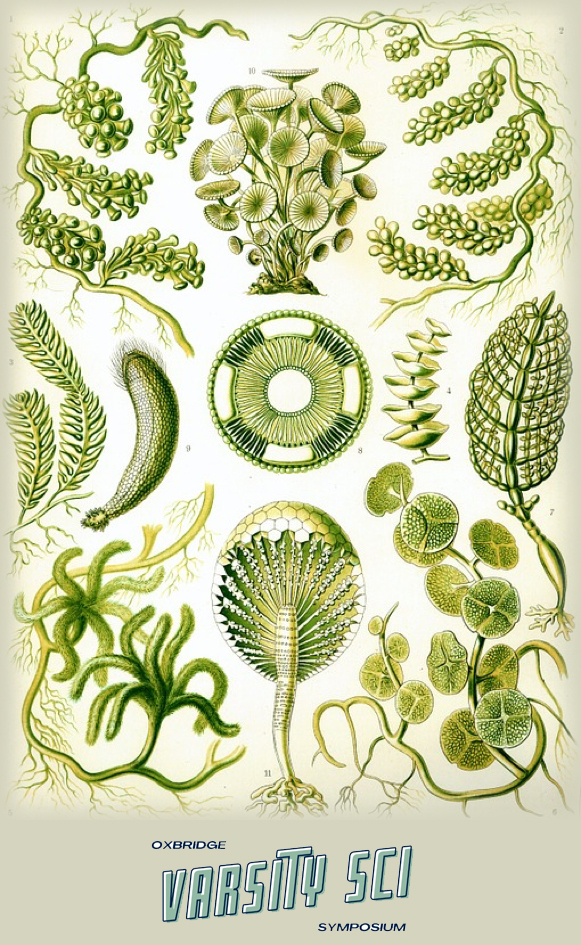Talk Summary by Barbara Walkowiak
The basics of photosynthesis, or why getting your own food is always challenging
In times of climate change and rising global population, sustainable and efficient food production is of vital importance. The secret to improving crop yields may lie in the algal chloroplast, as powerfully described by Ella Catherall in her engaging talk for the 2020 VarsitySci symposium.
Plants are world-famous for being autotrophic, which means they can produce their own food. This is achieved during photosynthesis, when firstly, in the light-dependent phase, they synthesize ATP, the molecule responsible for driving processes in our body by providing chemical energy. After the reduction of an electron carrier—the process of ‘giving’ it an electron—, the second, light-independent phase of photosynthesis begins. During this phase, molecules of carbon dioxide are fixated by an enzyme called RuBisCO. The enzyme is responsible for binding molecules of CO2 and a five-carbon sugar — the first step in a series of chemical reactions that eventually lead to the synthesis of glucose. Therefore, RuBisCO is the key for efficient photosynthesis.
However, it is not faultless: it has evolved with higher affinity to oxygen than to CO2, which means that it is more ‘willing’ to take on oxygen molecules from the air if their concentration is high enough.
And if it does so, things can go very wrong for the plant. If RuBisCO doesn’t fixate carbon, glucose cannot be synthesized. Even worse, the compounds produced when RuBisCO fixates oxygen in place of CO2 are toxic to the plant! For this reason, plants all over the world have evolved carbon concentrating mechanisms (CCMs) to prevent RuBisCO from binding to oxygen instead of CO2. The idea is to accumulate as much CO2 as possible in their tissues so that the enzyme is not ‘distracted’ by any stray oxygen molecules.
Why algal chloroplasts are special
But out of all the plants dealing with this problem, there is one particular group that has it the worst, and these are green algae living in aquatic environments. CO2 is not very well dissolved in water, where it is mainly present in the form of bicarbonate ions (HCO3-), so green algae have much less CO2 available.
How did they then overcome this challenge?
It turns out that green algae have special sub-cellular structures in their chloroplasts, called pyrenoids. Pyrenoids are highly specialized micro-compartments that play an essential role in concentrating carbon in the chloroplasts of green algae. Their formation starts with an assembly of EPYC1, a protein with four main domains, and RuBisCO. EPYC1 groups RuBisCO by attaching one molecule of the enzyme to each of its domains. These clusters form the pyrenoid, which is separated from other chloroplast structures by a starch sheet.

But how does CO2 reach the RuBisCO enzyme in the pyrenoids? The answer lies in thylakoid membranes, which form tubules allowing transport of substances between the pyrenoid and the chloroplast. They create tunnels which transport bicarbonate ions to the pyrenoids. When bicarbonate ions get there, the enzyme carbonic anhydrase dehydrates them to obtain CO2. This increases CO2 concentration close to RuBisCO, which makes it a lot easier to prevent O2 fixation.
Even more amazingly, pyrenoids are inducible, which means that instead of staying in the chloroplast all the time, they come and go as they please — or rather, as the conditions in the environment of green algae keep changing.
Will pyrenoids transform agriculture?
With their unique features, pyrenoids seem like the best starting point for engineering crops whose RuBisCO enzymes are prevented from going off the rails and binding oxygen instead of CO2. And there is some hope— since many land plants have evolved a similar mechanism of carbon concentration, introducing pyrenoids into their chloroplasts should be feasible.
However, the task is not as simple as it sounds. As it turns out, the RuBisCO enzyme found in higher plants may not be fully compatible with pyrenoids, as it does not interact with EPYC1 in the required way. Also, land plants lack bicarbonate transporters, which are needed to transport bicarbonate ions to the RuBisCO-EPYC1 clusters. Even if we do manage to fix the bicarbonate transporters, there is also the carbonic anhydrase to consider. This enzyme is highly active in land plants and would dehydrate bicarbonate before it gets to the RuBisCO molecules in the pyrenoid. Moreover, there is still a lot to learn — we do not know how pyrenoids, as inducible organelles, are regulated, nor do we have a grasp of why thylakoid membranes start creating tubules.
Despite the challenges we face, pyrenoids are worth studying. They not only contribute to our understanding of how plants work, but also present an intriguing jigsaw for scientists, offering great potential to make a real change in the world.
I am not sure if this edit makes the issue most clear. How about “…best starting point for engineering crops whose RuBisCO enzymes tend to go off the rails and bind oxygen instead of CO2. Providing them with pyrenoids would prevent that, and significantly increase crop yields, which would be an important step towards improved food security. And there is some hope…”?
This article gives a report of the talk given by Ella Catherall on the 22nd of September- Day 2 of the Oxbridge Varsity Sci Symposium.





